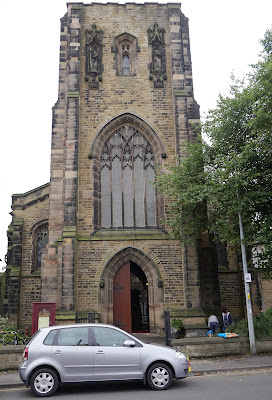Arighi Bianchi
I had been to Macc, as the locals call it, before but never had a proper look around. I started my walk at the station and immediately walked away from it in the direction of Buxton to see the wonderful Arighi Bianchi shop (when we bought some dining room furniture many years ago) of 1882-3. Along the Buxton Road on the right, are the attractive Fence Almshouses of 1895.
Returning to the station I climbed the celebrated 108 Steps towards the town centre. They could do with some attention.
You emerge behind the medieval church of St Michael and All Angels (previously All Hallows according to Pevsner). Much of it was rebuilt around 1900 by Sir Arthur Blomfield, but the oldest remaining parts are on the south side: the Savage chapel (1504) on the right and the Legh chapel (1422) on the left.
Inside, I found the Savage chapel to be more interesting with some wonderful stained glass (the three Graces) by Morris & Co from cartoons by Burne-Jones.
To the right of the church as you exit onto the Market Place is the Georgian Town Hall of 1823-4 by Francis Goodwin.
On the opposite side of the Market Place is the curious "Ye old shop" (at least it's not Ye olde shoppe!) of 1897, with art nouveau style decoration.
Off to the left, in Mill St, was a nice art deco shopfront.
I headed in the opposite direction, passing the Tourist Office where a kind lady gave me a copy of the Macclesfield Heritage Trail, to reach Jordangate. On the corner was the former Macclesfield Arms, once a coaching inn and then a hotel. I must say it doesn't look like one. Opposite was the imposing Jordangate House, rather spoilt by the blue colour scheme.
Now along King Edward St past the King Edward St chapel, one of the oldest Dissenting chapels, dating back to 1690. Unfortunately it was closed. Further along on the right was a pub with a thoroughly odd name of The cock in treacle.
At the junction with Churchill Way and off to the right were Stanleys Almshouses, founded in 1870. Four blocks form three sides of a courtyard. Two others were added in 1927 extending the development into Cumberland St.
I turned into Churchill Way and then right into Chestergate. In Bridge St, on the right, I spotted this impressive building with its battlemented tower. It turned out to be the Drill Hall of 1871.
Returning to Chestergate, I passed the interesting Picturedrome, the town's first cinema. It was converted into a bingo club in the 1970’s into offices in 2000.
My real purpose in heading out here was to see A W N Pugin's St Alban's church in Chester Road. It was funded by the Earl of Shrewsbury and built 1839-41. It was intended to have had a much larger tower but this was never finished.
Inside there is a rood screen as Pugin thought should have and some lovely stenciled decorations.
Heading back into town I passed Christ Church (1775-6), somewhat reminiscent of St John the Baptist in Knutsford which I saw the other day. It was built by Charles Roe, a wealthy local businessman. The tower was deliberately raised to a height to match that of St Michael and all Angels.
I returned to the centre via Bridge St and Roe St to reach the Heritage Centre. It is housed in a building which was once the Sunday School. I found this quite astonishing until I read in the Heritage Trail booklet that 1600 children who worked in the silk industry for which Macc was famous attended the school.
From here back to the station passing near the Silk Museum, but now with no time left to have a look.
Conditions: grey, but dry and mild.
Distance: about 3 miles.
Rating: four stars. Interesting and varied.
















No comments:
Post a Comment